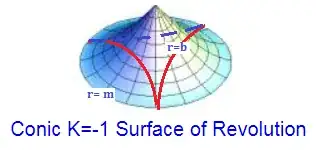On a spherical surface $K=+1$ a curvilinear triangle with $60^{\circ}$ at each vertex cannot be drawn because the spherical excess $ \pi - 3 A =0 $ and so its area vanishes. (By virtue of Gauss-Bonnet theorem).
Similarly on a pseudospherical surface $K=-1$ a curvilinear triangle with $60^{\circ}$ at each vertex cannot be drawn because the pseudospherical defect $3 A - \pi =0 $ and vanish.
Such a construction is impossible however small the size of geodesic triangle be. It requires that the lines should be concurrent when applied to elliptic/hyperbolic situations like a star made by three concurrent geodesic arcs.
What actually prevents formation of such "triangles" of vanishing enclosed area ?
EDIT1:
An attempt to go further in such a search: By drawing three equal geodesic arcs across cuspidal equator $ (K=-1)$ hypo pseudosphere roughly as per sketch we can/may have a zero area enclosed between them surrounding singularity of cone vertex,of course with additional and appropriate interpretation/condition. Corner angles at cuspidal equator is $\pi/3.$
Two related real constants $(b,m)$ arise in geodesic calculation which should be found from a definite integral.
$$\int_{b}^{m} \frac{dr}{r\sqrt{((r/b)^2-1)(1-m^2+r^2)}} = \frac{\pi}{3}$$
Request your help in their determination.
